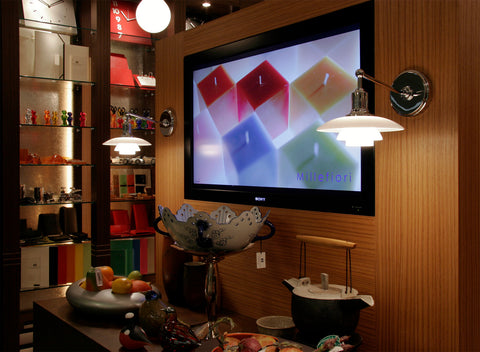





PH 2/1 Wall Lamp
The fixture is designed based on the principle of a reflective three-shade system, which directs the majority of the light downwards. The shades are made of mouth-blown opal three-layer glass, which is shiny on the top and sandblasted matte on the inside, giving a soft and diffuse light distribution.
Poul Henningsen developed the three-shade system in 1925-1926 in collaboration with Louis Poulsen for an exhibition in Paris. This partnership lasted until Henningsen's death in 1967. His goal was to create glare-free light with soft shadows using incandescent bulbs.
Today, the three-shade family includes 30 lights, including outdoor models. This versatile system has spawned around a thousand different models over the years, ranging from table and floor lamps to chandeliers popular in 1930s homes. Options included various colors, sizes, and materials like metal and later glass for the shades, which allowed both downward-directed light and room illumination.
Henningsen's scientific approach, using the logarithmic spiral, ensured even light distribution and controlled glare and shadow. Each shade's size was denoted by model numbers like PH 2/1 Wall, which features an approximately 20 cm top shade and lower shades from the 1/1 model. These hybrid models emerged from the need to accommodate pendant lighting at lower heights across wall, floor, and table lamps.
This product doesn't have any reviews yet. Be the first to bring iconic design into your home and share your thoughts!
Width: 7.9"
Height: 6.5"
Length: 11.7"
Cable length: 114"
Materials:
Shades: Hand-blown white opal glass
Wall box: High lustre chrome plated, spun brass
Suspension: High lustre chrome plated, spun aluminum
Arm: High lustre chrome plated, brass
1 x 10W LED E12 IP20
Electric shock protection II without ground
Dry location
cULus Listed
Most Louis Poulsen lighting fixtures come with a 5-year warranty. However, specific products have different coverage:
- Portable fixtures (such as table and floor lamps): 2-year warranty
- Separately purchased components (like replacement parts): 2-year warranty
Established in 1874 as a lighting manufacturer, Louis Poulsen has become one of the world's leading producers of lighting. This success is attributed to collaborations with renowned designers and architects like Arne Jacobsen, Øivind Slaatto, Poul Henningsen, and Verner Panton.



